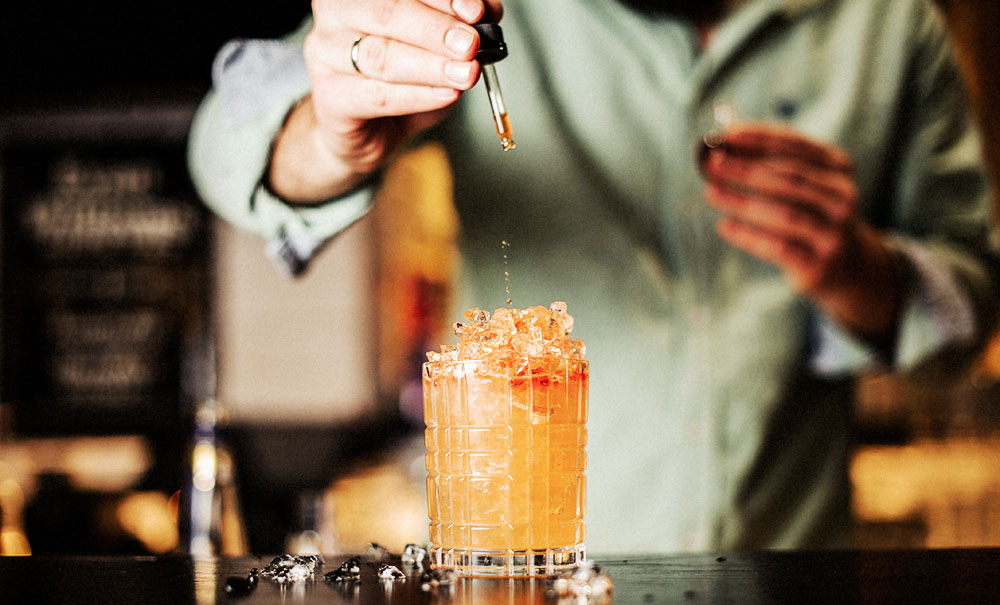Bitters and Tinctures: Cocktail tips from the experts

Whipping up the perfect cocktail is an art form in and of itself. There is a reason why talented mixologists and bartenders receive high acclaim in the cocktail world. I recently spoke with three award-winning bartenders to get their advice on how I, a home bartender with limited cocktail knowledge (and resources), can make the perfect cocktail at home. One big question I had was: what exactly are “bitters” and “tinctures”… and what’s the difference between the two?
“Bitters contain bittering agents such as wormwood, cassia bark and gentian. Tinctures do not,” Kaitlyn Stewart explains. Stewart shakes up cocktails for the Royal Dinette in Vancouver; she was also the 2017 World Class Bartender of the Year. She shared the recipe for her seasonal cocktail, Bonita Applebum, with us last fall. “Tinctures can be made from just about anything, as long as you are using an overproof spirit.”
Halifax-based bartender Chris Thibodeau goes a bit deeper, explaining that both bitters and tinctures season cocktails. “They’re the salt and pepper of the cocktail world,” he says. “You could see a tincture and a bitter used in the same cocktail, absolutely. You could use a couple of dashes of a tincture and then you’re still missing a bitter element in your cocktail, you still might go to a bitter as well. They’re similar flavours, it’s just bitters have that bitter characteristic behind them that tinctures don’t.”
Bitter elements in a cocktail round out the flavour, giving depth and lengthening flavours. If you’re making a cocktail that leans heavily towards the sweet or sour, a dash of bitters might just balance it out. A splash of a bitter-style tincture would also work. However, tinctures aren’t always bitter.
“A tincture could be sweet, or it could be spicy,” Thibodeau mentions. “It could have heat. It could be the same flavours as bitters, just not bitter.”
Both bitters and tinctures use spirits – alcohol – to create the flavour. In tinctures, the alcohol extracts the flavour; while in bitters, the alcohol is flavoured. “A tincture is a solution that has flavour from the use of alcohol to extract it,” says Makina Labreque, the Diageo Reserve Brand Ambassador and Activation Manager who won the Canadian leg of the 2019 Patrón Perfectionist competition with her Spruce Tip cocktail. “Bitters are similar in the fact that it is alcohol flavoured sharply with herbs, and other plant elements. However there are cocktail bitters, which are typical for using in dashes, and there are the digestif style bitters (or Amaro) that are typically lower ABV than a whisky or gin, and used to sip on or as a modifying spirit in a cocktail.”
“Amaro are fortified wines and liqueurs that are infused with the secret recipe of herbs and spices,” Thibodeau helpfully explains. “You’re never going to find out the recipe, though. They’re used more like a liqueur, where you’d be adding a quarter ounce or a half ounce, or maybe a full ounce. Whereas bitters, you would never use a full ounce in a cocktail.”
The idea of the digestif is important. Bitters, tinctures and amaros were all originally used to aid in digestion and soothe upset stomachs. “Bitters, tinctures and Amaro were used originally to cure common ailments,” Labrecque says. “Lots of people still use the classic Angostura Aromatic Bitters in ginger ale or soda water to help with an upset stomach. A shot of Fernet Branca works well, too. You can use all of these in a very similar manner – an easy suggestion is to use the amaro for modifiers in cocktails and the bitters/tinctures as a ‘spicing’ agent to create depth.”
To sum it all up. Bitters and tinctures are made using spirits. Bitters are exclusively bitter. They’re used in dashes and small doses only, to season cocktails and add depth. Tinctures are solutions made in whichever flavour profile you desire – bitter, sweet, spicy. They’re used in varying amounts to adjust the balance and flavour of a cocktail. Amaris (the plural of Amaro) are bitter liqueurs used as digestifs that can be added to cocktails or sipped solo.
Pretty simple, right?
So, how do you know when to use each or either? Overall, the sense I got from these experts is that you have to experiment. Experiment with the ratios, flavours and ingredients. Find that balance. Experiment until you’ve got your perfect cocktail. You’ll be able to read the rest of their tips and advice in the March/April 2020 Quench issue – which will be available in the coming week.
